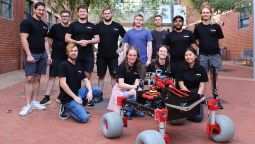Seeing dark matter in a new light

Artist's impression of a galaxy surrounded by gravitational distortions due to dark matter. Galaxies live inside larger concentrations of invisible dark matter (coloured purple in this image), however the dark matter's effects can be seen by looking at the deformations of background galaxies. Credit: Swinburne Astronomy Productions - James Josephides
In summary
- Swinburne astronomers have found a new way to ‘see’ the elusive dark matter halos that surround galaxies
- Their research focuses on an effect called weak gravitational lensing
- By measuring how distorted real galaxy images are, astronomers can calculate how much dark matter it would take to explain what they see
A small team of astronomers from Swinburne University of Technology has found a new way to ‘see’ the elusive dark matter halos that surround galaxies.
Our Universe is filled with many billions of galaxies. To our eyes – and in optical telescopes – these galaxies appear as collections of millions or even trillions of stars. However, this is just the tip of the iceberg.
One of the big puzzles of cosmology is that our telescopes only see a small fraction of the total mass that exists in the Universe.
“Most – about 85 per cent – of the mass in the Universe is effectively invisible,” says Swinburne PhD candidate Pol Gurri, who led the new research. “Unlike ordinary matter, this dark matter does not produce, absorb, or reflect light: it only interacts with the rest of the Universe via gravity.”
So how can you measure what cannot be seen? The key is to measure the effect of gravity that the dark matter produces.
“It’s like looking at a flag to try to know how much wind there is. You cannot see the wind, but the flag’s motion tells you how hard the wind is blowing,” Mr Gurri explains.
The new research focuses on an effect called weak gravitational lensing, which is a feature of Einstein’s general theory of relativity.
“The dark matter will very slightly distort the image of anything behind it,” says Associate Professor Edward Taylor, who was also involved in the research. “It is a bit like looking at a table through the base of a wine glass.”

ANU 2.3 metre telescope. Credit: Australian National University
The Swinburne team has used the ANU 2.3m Telescope, located near Coonabarabran, NSW, Australia to map how gravitationally lensed galaxies are rotating.
“Because we know how stars and gas are supposed to move inside galaxies, we know roughly what that galaxy should look like,” says Mr Gurri. “By measuring how distorted the real galaxy images are, then we can figure out how much dark matter it would take to explain what we see.”
The new research shows how this velocity information enables a much more precise measurement of the lensing effect than is possible using shape alone.
“With our new way of seeing the dark matter we hope to get a clearer picture of where the dark matter is, and what role it plays in how galaxies form,” Mr Gurri says.
Weak gravitational lensing is already one of the most successful ways to map the dark matter content of the Universe, with massive global investments of time and resources. NASA’s Nancy Grace Roman Space Telescope and the European Space Agency’s Euclid Space Telescopes (both scheduled to launch in 2022) have been designed, in part, to make similar kinds of measurements.
“We have shown that we can make a real contribution to these global efforts, even with a relatively small telescope built in the 1980s, just by thinking about the problem in a different way,” says Associate Professor Taylor.
The new work appears in the Monthly Notices of the Royal Astronomical Society.
This research was partially funded through an Australian Research Council Future Fellowship.
-
Media Enquiries
Related articles
-

- Astronomy
High school students work with Swinburne astronomers on the future of space
Swinburne’s Youth Space Innovation Challenge has inspired over 330 Australian teenagers to pursue a career in STEM.
Friday 26 July 2024 -

- Astronomy
- Science
Swinburne appoints new Director of Innovative Planet Research Institute
Leading geodesy expert, Professor Allison Kealy, has been appointed as the inaugural Director of Swinburne University's Innovative Planet Research Institute.
Monday 22 April 2024 -

- Astronomy
- University
OzGrav 2.0: A ‘new era of astrophysics’ launched at Swinburne
The next phase in the world-leading ARC Centre of Excellence for Gravitational Wave Discovery, dubbed 'OzGrav 2.0', launched this week at Swinburne University of Technology.
Wednesday 17 April 2024 -

- Design
- Astronomy
- Technology
- University
Swinburne ‘Rock Muncher’ takes part in Australian Rover Challenge
A multidisciplinary student team from Swinburne University of Technology competed in the 2024 Australian Rover Challenge held in Adelaide, South Australia.
Thursday 11 April 2024 -
.jpeg/_jcr_content/renditions/cq5dam.web.256.144.jpeg)
- Astronomy
New JWST observations reveal black holes rapidly shut off star formation in massive galaxies
New research showcases new observations from the James Webb Space Telescope that suggest black holes rapidly shut off star-formation in massive galaxies by explosively removing large amounts of gas...
Tuesday 23 April 2024

